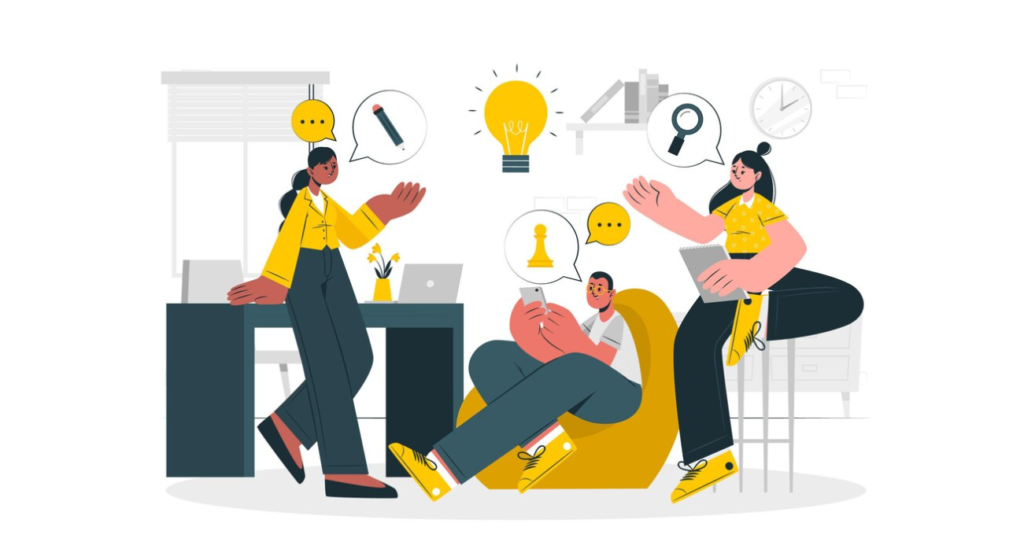At Ink Factory, we’re passionate about employing visual brainstorming methods to enhance our problem-solving skills and refine our services. Visual brainstorming is all about showcasing ideas and concepts, not necessarily drawing them out. Regardless of your expertise, you can excel in visual brainstorming.
Dive into the following guidelines to kickstart visual brainstorming in your office now!
Equip Yourself with Tools for Structured Creative Thinking
In the quest to enhance your creative thinking and bring structure to your ideas, Ink Factory promotes the idea of equipping yourself with a diverse set of tools. This arsenal of tools serves as the foundation for structured creative thinking. One fundamental principle we uphold is the establishment of a clear hierarchy within your thoughts and concepts. This hierarchy is pivotal in highlighting the importance of different pieces of information and how they relate to one another.
The beauty of creating a visual order lies in its flexibility. There are numerous techniques and approaches you can adopt to achieve this, but we advocate for a simple and effective strategy: assembling a toolkit and assigning specific tasks to each tool.
Once your toolkit is ready, you gain the ability to seamlessly dive into any of these methods and put them into action. This approach empowers you to convert your thoughts into structured visuals, unlocking the potential of your creative thinking. At Ink Factory, we are committed to helping you harness the power of these tools and methods to bring clarity and structure to your ideas, making them more impactful and visually compelling.
Visual Brainstorming Technique 1: The Ink Factory Approach
This framework is frequently employed not just at Ink Factory but in many innovative environments. Designed as a visual guide, it supports spontaneous thinking and ensures ideas flow freely across the canvas. Visual drawings can enhance the experience, but the framework itself doesn’t mandate them. By adhering to designated tools, the brainstorming process remains coherent and comprehensible.
- Step 1 – Setting the Stage: Use your large tool to inscribe the issue you wish to solve or ideate upon at the center of your canvas;
- Step 2 – Ideation Kickoff: Employ your medium tool to jot down as many ideas as possible while freely moving across the canvas. Concentrate on identifying your specific needs in relation to the problem you’re addressing at this stage;
- Step 3 – Expanding Ideation: Employ your small tool to revisit your ideas and capture any additional thoughts related to them. Concentrate on how these insights can address the problem you’re tackling;
- Step 4 – Evaluation and Distinction: Review all your ideas and utilize color to highlight the elements that stand out to you;
- Step 5 – Idea Organization: Utilize your visual notes to craft a comprehensive summary. This can be in the form of another visually organized note or in a text document. This stage helps you identify what is effective for your needs and for potential presentations.

Visual Ideation Method 2: Collaborative Creativity
This brainstorming technique, known as Groupthink, is best suited for team collaboration. While the first technique can be employed individually or in a group, Groupthink truly shines when used as a team effort. This approach proves most effective when your starting point for brainstorming is somewhat ambiguous. Perhaps you’re unable to precisely identify the issue or solution, or you’re grappling with an overwhelming array of possibilities that require narrowing down. Whatever the case, the Groupthink method can provide valuable assistance in these situations.
- Step 1: Title – Distribute individual sheets of paper to everyone. On each sheet, using a large writing or drawing tool, participants should jot down or sketch a simplified representation of what challenges them. Avoid elaboration; use only a few words or basic illustrations;
- Step 2: Commence the Ideation Phase – Pass the paper to another person. They should use a medium-sized tool to build upon the initial idea or drawing with their thoughts, expressed through text or imagery;
- Step 3: Continue the Ideation Phase – Hand the paper to a different person. With the smallest tool, encourage them to expand on the ideas and thoughts further. They can begin connecting and grouping concepts or adding conceptual visuals as they see fit;
- Step 4: Evaluation Phase – Return the paper to the original individual. They can now introduce color to highlight what resonates with them or piques their interest. Using both medium and small tools, they can add any additional ideas that come to mind;
- Step 5: Organize Your Ideas – On a fresh sheet of paper, compile the findings in a coherent manner.

Enhance Your Note-Taking Skills
Interested in mastering visual note-taking techniques from experts? Join us for a live workshop this September, where you can dive deep into the fundamentals of visual note-taking over two informative days.
September 14-15 | Virtual Event
Visual Note-Taking 101
Join us for our comprehensive online workshop, spanning six hours across two days. This visual note-taking bootcamp delves into the foundational skills honed and mastered by our experienced artists, elevating your visual note-taking abilities to new heights.
Conclusion
Visual brainstorming is a powerful tool to transform abstract thoughts into structured and tangible visuals. At Ink Factory, we’ve successfully utilized techniques such as The Ink Factory Approach and Collaborative Creativity to channel creativity efficiently, regardless of one’s artistic skills. Both methods offer unique paths to harness collective insights, be it individually or within a team setting. With the right tools and techniques, anyone can streamline their ideation process, making it more effective and visually engaging. Whether you’re a seasoned pro or just getting started, diving into visual brainstorming can immensely boost your creative and problem-solving capabilities. Join us in our upcoming workshops to further enhance your visual note-taking prowess.
While visual brainstorming techniques can enhance your creativity and problem-solving abilities, let’s now delve into an article about three distinctive trade show booth concepts to explore innovative ideas for your next trade show exhibit.
